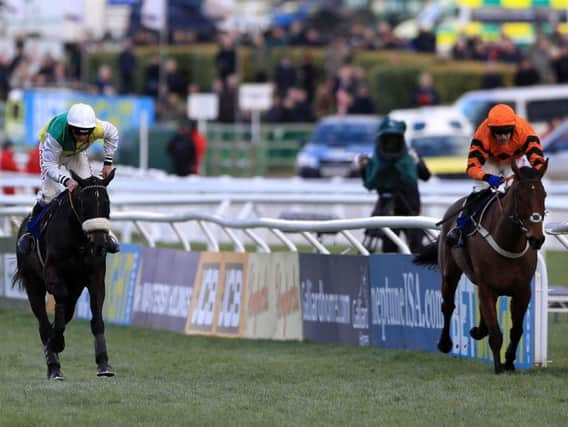Protests over death of Grand National hero Many Clouds


The Oliver Sherwood-trained 10-year-old collapsed and died shortly after the line following his victory over Gold Cup favourite Thistlecrack at Cheltenham on Saturday.
There had been concern over his well-being immediately after his Hennessy Gold Cup win of 2014 and his finest hour in the Grand National at Aintree in 2015, but he swiftly recovered on both occasions.
Advertisement
Hide AdAdvertisement
Hide AdSherwood's stable star underwent a breathing operation before the new season and appeared arguably better than ever in winning on his reappearance at Aintree in December, before his epic victory over King George winner Thistlecrack in the Cotswold Chase.
But quoted in the MailOnline, Dene Stansall of Animal Aid said he wrote to the BHA some 10 months ago to warn them of his concerns and that the horse should be withdrawn from last year's National, in which he finished last of the 16 finishers.
He said: "There was an underlying problem with the horse. There were many reports that he had wobbles after races and needed oxygen. If a horse is needing oxygen at the end of a race it is very worrying."
He added: "Yesterday was an extremely hard race against the best in the country.
Advertisement
Hide AdAdvertisement
Hide Ad'Many Clouds was carrying 11st 10lb, had three miles to run and 21 fences to jump and it killed him.
'Someone has got to be held responsible. We are absolutely livid and we aim to take this further. The problem is the horse racing industry is self-regulated.
'But I will be speaking to a lawyer this week and there could be a case to report this to the police under the Animal Welfare Act - as the BHA knew it could happen - and they will have to investigate.
'This is significant, not only for Many Clouds, but for other horses."
Advertisement
Hide AdAdvertisement
Hide AdIn response, BHA media manager Robin Mounsey said: "First and foremost our thoughts are with all of those who would have loved and cared for Many Clouds throughout his great career.
"It is too early to say with any certainty what happened to Many Clouds. The BHA will help coordinate a post-mortem in the coming days to ascertain the cause of the incident. The horse was cared for by Cheltenham's team of vets within seconds of displaying any signs of distress. Sadly, it was not possible to save him. Incidents such as this are extremely rare.
"The symptoms exhibited by Many Clouds after his run in the Grand National are not uncommon in racehorses after exercise. It is linked to an increase in body temperature and can be treated by providing the horse with water. The BHA holds a list of all horses who exhibit these symptoms in order that they can be provided with water should they show the symptoms again. There is no existing veterinary evidence which links these symptoms with racehorse fatalities.
"Animal Aid are not a registered welfare charity. Their stated aim is to ban all horseracing despite the catastrophic impact this would have on the thoroughbred as a breed. Their understanding of this incident is entirely without evidence and not based on recognised veterinary science. The BHA works with recognised welfare organisations such as the RSPCA and World Horse Welfare.
Advertisement
Hide AdAdvertisement
Hide Ad"Since the year 2000 over £32million has been invested by British racing into veterinary science and research, which benefits all breeds of horses in Britain, not just thoroughbreds. The sport is currently engaged in several pieces of research aimed at gaining a better understanding and finding ways to reduce the likelihood of sudden equine fatalities which are thankfully extremely rare.
"These include Levy Board-funded research with experts at the University of Nottingham looking at the development of cardiac assessment technology. The BHA has also recently completed a racecourse study with the support of trainers to collect information on horses' post-race heart rhythms.
"Sudden equine fatalities can occur at rest as well as during exercise, and among seemingly healthy horses. They affect all equestrian sports including racing, eventing and show-jumping. Many are caused by heart attacks or internal haemorrhage, but there also a significant proportion where a definitive cause cannot be identified.
"The levels of care that the 14,000 horses in training at any one time receive throughout their lives is virtually unsurpassed by any other domestic or domesticated animal. In exchange for this care they are asked to do what they are bred to do, which is race. There is a level of risk associated with this, as with any exercise involving horses.
"The BHA is open and transparent about this risk. In jump racing that level or risk is just 0.4 per cent, a figure which has decreased by around one-third in the last 20 years."